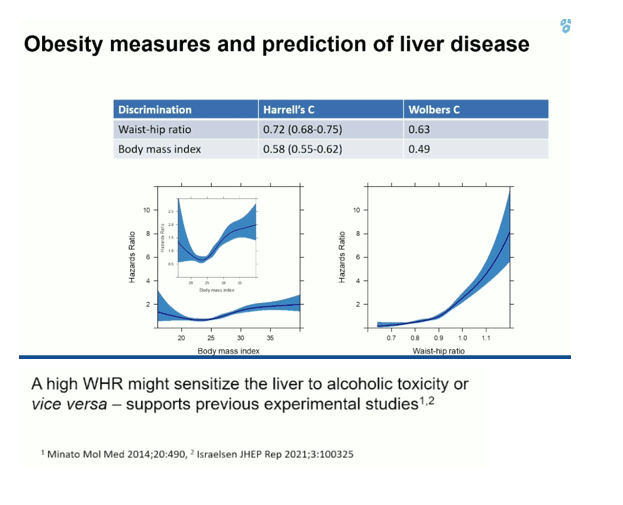 |
 |
 |
| |
Waist-to-Hip Ratio Predicts Liver Disease Better Than Body Mass Index
|
| |
| |
EASL International Liver Congress 2022, London, June 22-26, 2022
Mark Mascolini
In a 40,000-person general-population study in Finland, waist-to-hip ratio (WHR) as an obesity measure proved a stronger predictor of new liver disease than body mass index (BMI) [1]. The difference could explain apparent discrepancies in research on how obesity affects liver disease risk.
Researchers at Helsinki University Hospital and colleagues at other centers reminded EASL attendees that research independently links both obesity and alcohol use to chronic liver disease in the general population. But findings are mixed on possible interaction effects between alcohol and obesity on liver disease risk. Notably, the Helsinki team said, a recent systematic review found no interaction between BMI and alcohol for liver disease [2].
The investigators proposed that WHR "reflects fat distribution and abdominal obesity, and seems to reflect metabolic health better than BMI." Indeed, WHR predicted liver disease better than BMI in certain studies, but population-based data on this question are scanty. To address these issues, the Helsinki team planned a study with two aims: to compare the performance of BMI and WHR in predicting incident (newly diagnosed) severe liver disease; and to study potential interaction effects between these obesity metrics and harmful alcohol use in predicting severe liver disease.
The analysis involved people in the FINRISK 1992, 1997, 2002, 2007, and 2012 studies and in the Health 2000 study. These groups constituted representative samples of the Finnish general population. The researchers linked baseline individual data to national healthcare registries that record hospital admission, cancer, and death related to liver disease. The investigators excluded people who already had liver disease, who had chronic viral hepatitis, or who lacked data critical to the analysis.
All 40,923 study participants had weight, height, and waist and hip circumference measured. Standard questionnaires evaluated alcohol use. For men, WHR was low if below 0.93, middle if 0.93 to 0.99, and high if above 0.99. For women respective values were below 0.80, 0.80 to 0.86, and above 0.86. Low, middle, and high BMI were the standard cutoffs for normal weight, overweight, and obesity. For men low alcohol use was below 176 g/week, middle use 176 to 392, and high use above 392. For women respective alcohol cutoffs were below 120 g/week, 120 to 280, and above 280.
The 40,923 adults studied averaged 50 years in age and 47% were men. Proportions of the study group in low, middle, and high alcohol and obesity groups were 86%, 10%, and 4% for alcohol use, 31%, 38%, and 31% for WHR, and 36%, 41%, and 23% for BMI. During a median 12.9 years of follow-up, the researchers counted 355 liver-related outcomes.
WHR predicted liver disease more strongly than BMI by two methods: Harrell's C statistic (WHR 0.72, 95% confidence interval [CI] 0.68 to 0.75; BMI 0.58, 95% CI 0.55 to 0.62), and Wolbers C accounting for competing risks (WHR 0.63; BMI 0.49).
Next the researchers calculated excess cumulative incidence of liver disease after 10 years by alcohol- and BMI/WHR-group. The calculation involved subtracting the cumulative incidence in each group from the cumulative incidence in the reference group. For the alcohol-WHR analysis, the reference group was low alcohol use and no abdominal obesity. For the alcohol-BMI analysis, the reference group was low alcohol use and healthy BMI. Excess cumulative incidence after 10 years came to 2.8% in the alcohol-WHR group (P for interaction 0.01) versus only 0.2% in the alcohol-BMI group (P for interaction 0.06).
The researchers concluded that WHR, a marker of abdominal obesity, outperforms BMI in predicting newly diagnosed liver disease in the general population. They added that the "profound supra-additive interaction effect between alcohol use and WHR for incident severe liver disease" is not seen with alcohol and BMI.
References
1. Aberg F, Salomaa V, Farkkila M, et al. Abdominal obesity is key when evaluating interactions between alcohol use and obesity for liver disease. EASL International Liver Congress 2022, London, June 22-26, 2022. Abstract OS109.
2. Glyn-Owen K, Bohning D, Parkes J, Roderick P, Buchanan R. The combined effect of alcohol and body mass index on risk of chronic liver disease: a systematic review and meta-analysis of cohort studies. Liver Int. 2021;41:1216-1226. doi: 10.1111/liv.14754.
looking at the dip in the curve on the left. looking at this graph, losing weight is not always a good thing, if this weight loss means you are losing muscle mass for example due to illness, in contrast losing weight ina way that reduces your waist circumference in relation to your hip circumference is always good with regards to risk for liver disease.

|
| |
|
 |
 |
|
|